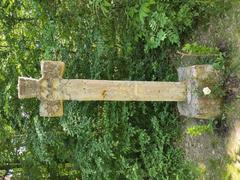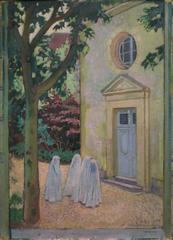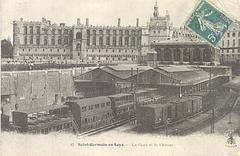Croix Saint-Simon: Visiting Hours, Tickets, and Comprehensive Guide to Saint-Germain-en-Laye Historical Sites
Date: 14/06/2025
Introduction
The Croix Saint-Simon is a captivating historical monument nestled within the picturesque Forêt de Saint-Germain-en-Laye, just west of Paris. This stone cross, with origins tracing back to medieval and early modern traditions, stands as a testament to centuries of religious devotion, royal patronage, and local identity in Saint-Germain-en-Laye. Accessible year-round and free to all visitors, the Croix Saint-Simon is a serene waypoint for those interested in French history, architecture, and natural landscapes. This guide provides detailed insights into the monument’s history, cultural significance, architectural highlights, practical visitor information, and its role among Saint-Germain-en-Laye’s many historical treasures (infosyvelines.fr; POP Culture; Monumentum; saintgermainenlaye.fr).
Historical Overview
Medieval and Early Modern Foundations
Saint-Germain-en-Laye’s origins date to 1020, when King Robert II founded a monastery dedicated to Saint Germain. This religious establishment catalyzed settlement and marked the area as a center of spiritual and royal significance (infosyvelines.fr). The Croix Saint-Simon, likely established in the context of expanding monastic lands, served as both a spiritual symbol and a territorial marker, a practice common in medieval France. During the 12th century, the construction of a fortified castle by Louis VI further elevated the town’s status. Crosses such as Saint-Simon were instrumental in delineating sacred spaces and guiding pilgrims (fr.geneawiki.com).
Religious and Cultural Significance
Devotional crosses dedicated to saints—like the Croix Saint-Simon, honoring Saint Simon the Apostle—were prominent fixtures in rural France. These crosses anchored local traditions, serving as gathering points for processions, blessings, and religious festivals, and reinforcing the community’s shared spiritual heritage (saintgermainenlaye.fr).
Renaissance to Revolution
The Renaissance saw Saint-Germain-en-Laye flourish as a royal residence, with the cross enduring as a symbolic constant through periods of architectural and political change (infosyvelines.fr). The Croix Saint-Simon witnessed landmark events, including royal processions and significant treaties. During the Hundred Years’ War and the Wars of Religion, the cross stood as a witness and, at times, a focal point for reconciliation and communal faith (en.wikipedia.org).
Modern Era: Preservation and Restoration
The 19th and 20th centuries brought renewed appreciation for Saint-Germain-en-Laye’s heritage. The arrival of the railway, the visit of Queen Victoria, and the establishment of the Musée d’Archéologie Nationale marked the town’s modern transformation. The Croix Saint-Simon underwent restoration after suffering during the French Revolution, and in 1926 it was officially protected as a Monument Historique, ensuring its ongoing conservation (POP Culture; Monumentum).
Architectural and Artistic Features
The Croix Saint-Simon is crafted from regional limestone, with a design characteristic of 17th-century wayside crosses. Its structure consists of a square base supporting a pedestal, upon which rises the Latin cross with chamfered arms and a gently tapering shaft. Subtle heraldic motifs reference the Saint-Simon family, and although inscriptions have faded, they once documented the cross’s origins and purpose (POP Culture; Monumentum). The monument’s weathered surface and integration into the forest setting lend it a timeless, contemplative aura.
Role in Local History and Spiritual Landscape
The Croix Saint-Simon is part of a network of devotional sites and oratories scattered throughout the Forêt de Saint-Germain-en-Laye. These monuments form the “Sentier des Oratoires,” a thematic walking route connecting key points of religious and royal history (Paris à l’Ouest). The cross’s placement at a crossroads symbolizes its historical role as both a guidepost and a spiritual waypoint for travelers, pilgrims, and local residents.
Visiting Information
Hours and Tickets
- Access: The Croix Saint-Simon is located in the Forêt de Saint-Germain-en-Laye and is freely accessible year-round; no ticket or reservation is required.
- Hours: Open at all times, though visits during daylight are recommended for safety and optimal viewing (saintgermainenlaye.fr).
Getting There
- From Paris: Take the RER A from central Paris to Saint-Germain-en-Laye (approx. 30 minutes). From the station, follow local signage or walking trails to reach the cross.
- By Car: Parking is available near forest entrances; follow marked trails on foot or by bicycle within the forest.
Accessibility
- The main forest paths are generally well-maintained, suitable for walking and cycling. Some uneven terrain may be encountered near the monument.
- Visitors with mobility challenges are encouraged to check with the local tourist office for the latest accessibility information.
Amenities and Tips
- The site is best enjoyed in spring or autumn, when the natural surroundings are especially vibrant.
- Public restrooms, cafes, and shops are available in the town center.
- Interpretive signage may be present; guided tours are occasionally offered, especially during local heritage events (Triplyzer).
Nearby Attractions
- Château de Saint-Germain-en-Laye: Former royal château now housing the National Archaeology Museum.
- Église Saint-Germain: Historic church with connections to French and English royalty.
- Domaine National de Saint-Germain-en-Laye: Expansive parklands, ideal for walks and panoramic views.
- Sentier des Oratoires: An 18-kilometer heritage trail linking the forest’s spiritual and historical landmarks (Paris à l’Ouest).
Conservation and Community Engagement
As a protected Monument Historique, the Croix Saint-Simon benefits from ongoing conservation under municipal and national oversight (POP Culture). Restoration campaigns and educational programs foster public appreciation for the site, and the cross features regularly in heritage walks and cultural events.
Frequently Asked Questions (FAQ)
What are the visiting hours of Croix Saint-Simon?
Accessible year-round, 24 hours a day; recommended during daylight.
Is there an entry fee?
No, the site is free to visit.
Are guided tours available?
Guided tours including the cross are occasionally organized during heritage events; check with the tourism office for schedules.
Is the site wheelchair accessible?
Forest terrain may present challenges; contact the tourist office for up-to-date accessibility details.
Visual Resources
For images and interactive maps, refer to local tourism websites and the Musée du Patrimoine. Alt tags such as “Croix Saint-Simon historic cross in Saint-Germain-en-Laye” support accessibility and SEO.
Summary
The Croix Saint-Simon is a powerful symbol of Saint-Germain-en-Laye’s layered history, blending religious tradition, royal legacy, and community spirit. Freely accessible and integrated into scenic forest trails, it is a must-see for those interested in French heritage and spiritual landscapes. Its enduring presence, ongoing preservation, and role in local cultural life invite visitors to connect with the region’s rich past and tranquil present (POP Culture; infosyvelines.fr; Monumentum; saintgermainenlaye.fr; Paris à l’Ouest).
Plan Your Visit
For detailed guides, downloadable maps, and updates on local events, consult the Saint-Germain-en-Laye official website and local tourism office. Enhance your experience with the Audiala app for guided tours, interactive resources, and the latest cultural news.
References
- Saint-Germain-en-Laye histoire ville dates clés – Infos Yvelines
- Croix Saint-Simon Monument Historique – POP Culture
- Visiting the Croix Saint-Simon in Saint-Germain-en-Laye – Official Site
- Saint-Germain-en-Laye – Wikipedia
- Sentier des Oratoires and Croix Saint-Simon – Paris à l’Ouest
- Things to do in Saint-Germain-en-Laye – Triplyzer
- Croix Saint-Simon de Saint-Germain-en-Laye – Musée du Patrimoine
- Monumentum – Croix Saint-Simon




